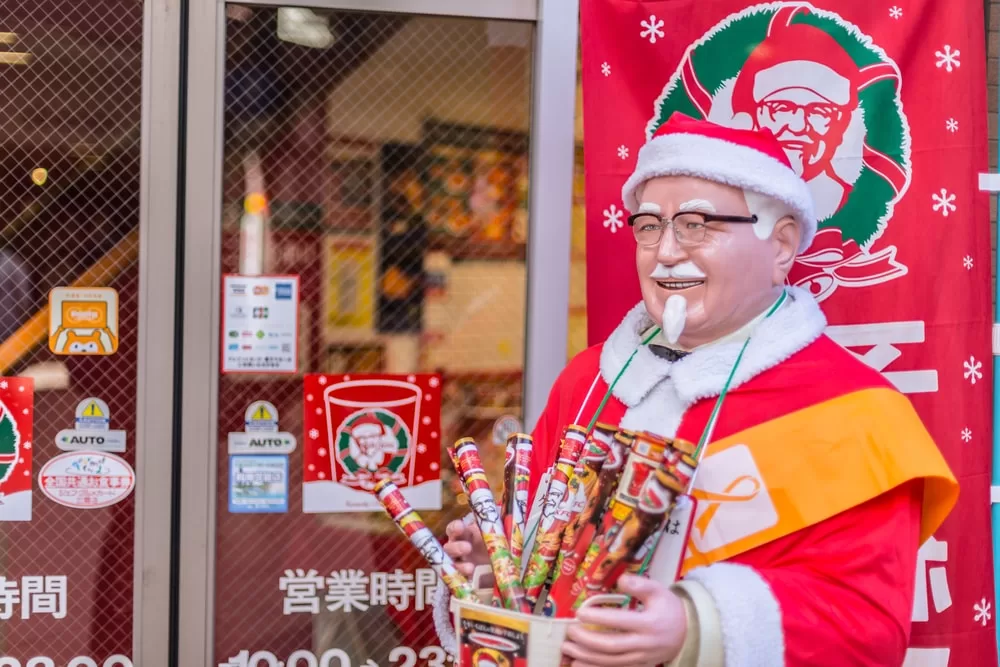It shouldn’t come as much of a surprise that the typical American Christmas dinner originates from the United Kingdom. We may have swapped out the Christmas pudding for apple pie and shunned the British mainstay of brussels sprouts, but we still have the ham, mashed potatoes and gravy. According to legend, Henry VIII was the first monarch to eat a turkey for Christmas, and thereon after the British serve both a ham and a turkey on the day. Since Victorian times, the meal hasn’t changed much in either country. We can thank the British for that longstanding tradition that defines the dinner table when the family comes together. And, to pay it forward, the United States eventually gave another country a holiday meal tradition.
On Christmas day, the people of Japan get a bucket of Kentucky Fried Chicken.
Resulting from four years of negotiation between the American parent KFC and the Mitsubishi Corporation, Mitsubishi was finally allowed to open the first Japanese KFC in the suburbs of Nagoya in 1970. After struggling for a few years, more outlets began to appear in areas with a large expatriate population. And then one dream changed everything.
Shortly after the first restaurant opened, its manager, Takeshi Okawara, woke up in the middle of the night having dreamed about offering a KFC “party barrel” at Christmas, full of chicken and all the sides. He claims the idea had been unconsciously planted in his mind by overhearing a foreign couple complain that they couldn’t get a turkey for a Christmas dinner. He hoped his party barrel would serve as an attractive substitute. By 1974 the plan had been so successful that it was adopted nationally, called Kurisumasu ni wa Kentakkii, or Kentucky for Christmas. Just like that, Colonel Sanders was donned in a Santa suit, and Takeshi Okawara eventually became president and CEO of KFC Japan, serving in that role for 18 years.
Presently, most people in Japan eat KFC on Christmas. Those who don’t preorder their meal weeks in advance might have to wait in line for hours on the day itself. The standard party barrel has evolved into family packages that can include cake and wine in addition to the chicken, with some dinners costing the equivalent of almost $50. These elaborate packages account for almost one-third of the company’s sale on the island, as it is estimated that 3.6 million Japanese eat KFC chicken on Christmas.
The phenomenon of Kentucky Fried Chicken in Japan has been studied by marketing and economics professors for decades, and other firms have been envious of the fast food chain’s unusual success there. With only one percent of the population being Christian, the Japanese had never celebrated Christmas. However, as they became more westernized they grew aware of the tradition, but without any cultural way to mark it. As Joonas Rokka, a French associate professor of marketing points out, KFC filled a void by coming in and suggesting that Christmas should be celebrated by eating fried chicken.
The KFC Christmas party bucket might be one of the best symbols of globalization we have. All the cultures of the world, having evolved in relative isolation the last several hundred to thousands of years, are now suddenly confronted with each other due to technology like airplanes, mobile phones and the internet. It is not uncommon for traditions in one country to get imported to another and translated in a new way. Many of American’s distinctive customs originated from somewhere else. The fireworks we set off on the 4th of July were used in 9th century China to ward off evil spirits and bring luck. Barbeques came from the Spanish after they witnessed the Caribbean people slow roasting pigs. Wearing masks on Halloween was an ancient Irish tradition to hide themselves from dead spirits. It was the US that turned it into a sugar overload and exported it back to Ireland.
It’s hard to say how traditions or customs may change in the future. As the world gets smaller and we learn more about each other around the globe, there might be opportunity for customs to be picked up in new places. There’s already been a movie about Krampus, the half-goat half-demon that punishes bad children in Central Europe during the Christmas season, and who knows if one day we’ll try going to the Christmas evening service in roller skates, like in Venezuela. On the other hand, there’s also the danger that some longstanding practices can subsumed by commercialization, as long as some company can make a profit somewhere. After all, Coca Cola created the image of a Santa Claus with a white beard and red clothes that we all know today. In light of such considerations the example of Japan becomes both humorous and a little unsettling. It makes one question how much control corporations dictate over social norms. While I love fried chicken as much as the next person and wouldn’t disparage anyone eating it on any day they pleased, the power of modern marketing can make one feel a little protective of customs that evolved organically for hundreds of years.
McDonald’s for Easter anyone?
This article is part of The Milk House Column series, published in print across three countries and two languages. It can also be found at themilkhouse.org.
This article appeared in a similar form in Progressive Dairyman and Farm and Livestock Directory.

